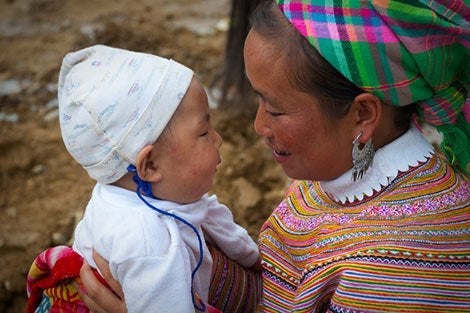For immediate release: December 22, 2015
Boston, MA – Continuous skin-to-skin contact with their mothers during the first days of life may reduce low birth weight infant deaths by more than one-third compared to conventional care, according to a new meta-analysis by researchers from Harvard T.H. Chan School of Public Health and Boston Children’s Hospital.
The meta-analysis combined studies which examined the effect of kangaroo mother care (KMC) or skin-to-skin care, typically practiced with exclusive breastfeeding, on neonatal outcomes. The most dramatic reduction in mortality rates was for low birth weight or preterm babies. Among heavier or full-term babies, there were also beneficial effects on their oxygenation, temperature regulation, and pain tolerance.
“While KMC or skin-to-skin care is particularly useful for low birth weight babies born where medical resources are limited, developed and developing countries are moving to ‘normalize’ KMC or skin-to-skin as a beneficial practice for all newborns and mothers,” said senior author Grace Chan, MD, MPH, PhD, instructor at Harvard Chan School and a faculty member at Boston Children’s Hospital.
The paper appears online December 22, 2015 in Pediatrics.
As many as 4 million babies worldwide die each year during their first month of life, and infants born early or at a low birth weight are at particular risk. Health technologies such as incubators can help improve outcomes in high-risk infants; however, such equipment is not widely available in low- and middle-income countries, where 99% of all neonatal deaths occur.
Lead author Ellen Boundy, SD ’15, who worked on the study while at Harvard Chan School and is an epidemiologist at the Massachusetts Department of Public Health, Chan, and co-authors analyzed 124 studies published between 2000 and 2014 that looked at skin-to-skin contact as a component of KMC. Some studies included additional care practices such as breastfeeding and close follow-up in their definition of KMC.
They found that among newborns weighing less than 2000 grams (4.4 pounds) who survived to receive KMC, there was a 36% reduction in mortality and 47% lower risk of sepsis or major infection. Newborns who received KMC also had higher oxygen levels and head circumference growth, as well as lower pain measures. In addition, KMC increased the likelihood of exclusive breastfeeding at hospital discharge by 50%. The results were relatively consistent across low- middle- and high-income countries.
The study was funded by Saving Newborn Lives initiative (SNL) of Save the Children.
“Kangaroo Mother Care and Neonatal Outcomes: A Meta-analysis,” Ellen O. Boundy, Roya Dastjerdi, Donna Spiegelman, Wafaie W. Fawzi, Stacey A. Missmer, Ellice Lieberman, Sandhya Kajeepeta, Stephen Wall, Grace J. Chan, Pediatrics, December 22, 2015, doi: 10.1542/peds.2015-2238.
Visit the Harvard Chan website for the latest news, press releases, and multimedia offerings.
For more information:
Karen Feldscher
kfeldsch@hsph.harvard.edu
(o) 617.432.8439; (m) 617.930.5558
Erin Tornatore
Boston Children’s Hospital
Erin.Tornatore@childrens.harvard.edu
617.919.3110
photo: iStockphoto.com
###
Harvard T.H. Chan School of Public Health brings together dedicated experts from many disciplines to educate new generations of global health leaders and produce powerful ideas that improve the lives and health of people everywhere. As a community of leading scientists, educators, and students, we work together to take innovative ideas from the laboratory to people’s lives—not only making scientific breakthroughs, but also working to change individual behaviors, public policies, and health care practices. Each year, more than 400 faculty members at Harvard Chan School teach 1,000-plus full-time students from around the world and train thousands more through online and executive education courses. Founded in 1913 as the Harvard-MIT School of Health Officers, the School is recognized as America’s oldest professional training program in public health.
Boston Children’s Hospital is home to the world’s largest research enterprise based at a pediatric medical center, where its discoveries have benefited both children and adults since 1869. More than 1,100 scientists, including seven members of the National Academy of Sciences, 11 members of the Institute of Medicine and 10 members of the Howard Hughes Medical Institute comprise Boston Children’s research community. Founded as a 20-bed hospital for children, Boston Children’s today is a 404-bed comprehensive center for pediatric and adolescent health care. Boston Children’s is also the pediatric teaching affiliate of Harvard Medical School. For more, visit our Vector and Thriving blogs and follow us on our social media channels: @BostonChildrens, @BCH_Innovation, Facebook and YouTube.
